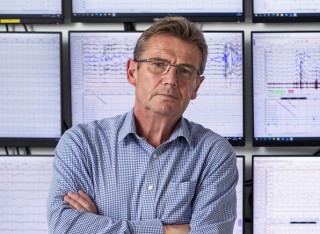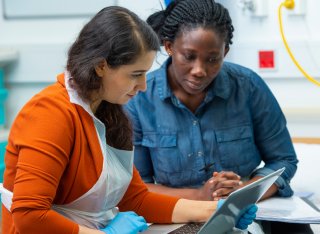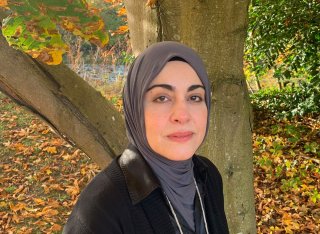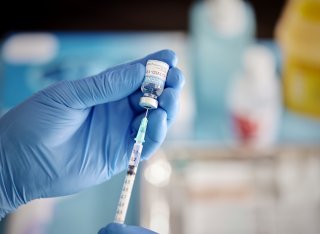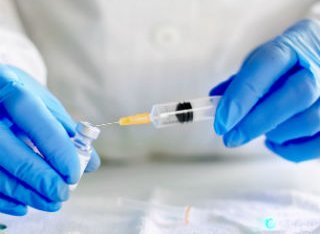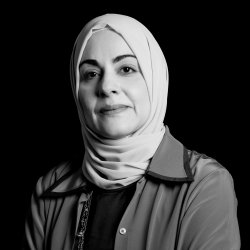
Dr Hana Hassanin
About
Biography
Dr Hana Hassanin is the Medical Director of Surrey Clinical Research Facility. She is a clinical consultant for the Dementia Research Institute (DRI) at the Surrey Sleep Research Centre. Hana has a joint appointment with the Royal Surrey Foundation Trust as the Director of the NIHR Royal Surrey CRF.
Hana had her medical training in internal medicine at the University Hospital of Giessen in Germany. She then worked in Heidelberg University Hospital and was awarded her MD from the “German National Centre for Tumour diseases” in oncology and immunotherapy with a special focus on Pancreatic Adenocarcinoma. She has also obtained a PGDip in Diabetes from Cardiff University.
Hana has extensive experience in the field of “Clinical Pharmacology and Therapeutics”. She led as PI/CI over 60 clinical trials- including global multi-national trials- in various therapeutic areas both early and late phase covering osteoporosis, vaccines, cardiovascular, oncology, and immunology.
Hana is passionate about teaching and research and has received the recognition award for broadening the understanding of clinical trials in the international educational event (Aware For All) organised by CISCRP.
News
Publications
Arousal dysfunction contributes to impairments seen in Alzheimer's disease. However, the nature and degree of this dysfunction have not been studied in detail. We investigated changes in tonic and phasic arousal using simultaneous pupillometry-EEG, relating these changes to locus coeruleus integrity, a key arousal nucleus. Forty Alzheimer's disease participants and 30 controls underwent neuropsychological testing using the Alzheimer's Disease Assessment Scale-Cognitive Subscale (ADAS-Cog), MRI designed to show contrast in the locus coeruleus as a measure of integrity and simultaneous pupillometry-EEG during 5 min of eyes-open resting-state. Pupillometry-EEG was then also applied during an oddball task which included a passive session and sessions in which responses to target stimuli were required, to test the effect of salience. Alzheimer's disease had lower locus coeruleus integrity (b = -0.26, P = 0.02) and lower peak alpha frequency (tonic arousal) (b = -1.09, P < 0.001). Both were related to ADAS-Cog. There was a very strong relationship between pupil size and both periodic and aperiodic EEG power. Cortical slowing in Alzheimer's disease affected this relationship, particularly at low frequencies. During the attentionally demanding oddball task, Alzheimer's disease participants' behavioural performance was impaired, with reduced accuracy and slower and more variable reaction times. They also had reduced pupil responses to salient stimuli (phasic arousal) (estimate = -0.19, P < 0.001). EEG and pupil measures of pre-stimulus tonic arousal were strongly correlated and predicted behavioural responses in both groups. Arousal fluctuations at rest and in response to stimuli are abnormal in Alzheimer's disease as measured by combined pupillometry and EEG. Salient stimuli that require a behavioural response are accompanied by a phasic increase in arousal, demonstrated by pupil dilation to oddball stimuli. This response is slower and of smaller magnitude in Alzheimer's disease patients. Cortical slowing (reduced peak alpha frequency) is seen in Alzheimer's disease, and this is modulated by arousal level and relates to overall cognition. Pupil-linked arousal responses and alpha EEG fluctuations are tightly coupled, but cortical slowing in Alzheimer's disease influences this coupling. The tools used here to measure neurophysiological arousal level have potential in understanding the nature of arousal system dysfunction in Alzheimer's disease at the group level. These tools may also be used as biomarkers at the individual level in order to target patients most likely to benefit from arousal-modulating medications.
Time-of-day variation in the molecular profile of biofluids and tissues is a well-described phenomenon, but—especially for proteomics—is rarely considered in terms of the challenges this presents to reproducible biomarker identification. We provide a case study analysis of human circadian and ultradian rhythmicity in proteins, including in the complement and coagulation cascades and apolipoproteins, with PLG, CFAH, ZA2G and ITIH2 demonstrated as rhythmic for the first time. We also show that rhythmicity increases the risk of Type II errors due to the reduction in statistical power from increased variance, and that controlling for rhythmic time-of-day variation improves statistical power and reduces the chances of Type II errors. We recommend that best practice in proteomics study design should account for temporal variation and that time of sampling be reported as part of study metadata. These simple steps can mitigate against both false and missed discoveries, as well as improving reproducibility.
Study Objectives: Portable electroencephalography (EEG) devices offer the potential for accurate quantification of sleep at home but have not been evaluated in relevant populations. We assessed the Dreem headband (DHB) and its automated sleep staging algorithm in 62 older adults [age (mean±SD) 70.5±6.7 years; 12 Alzheimer’s]. Methods: The accuracy of sleep measures, epoch-by-epoch staging, and the quality of EEG signals for quantitative EEG (qEEG) analysis were compared to standard polysomnography (PSG) in a sleep laboratory. Results: The DHB algorithm accurately estimated total sleep time (TST) and sleep efficiency (SEFF) with a Symmetric Mean Absolute Percentage Error (SMAPE)
AimsIn studies requiring repeated blood sampling, a cannula is typically inserted into a peripheral vein and used for regular blood draws. In some studies, subtherapeutic doses of heparin is infused overnight to maintain cannula patency; however, there is limited evidence supporting its use in this context. Normal saline infusions have been proposed as an alternative for extending cannula lifespan. This study aims to address the clinical need for data on blood collection techniques in healthy participants.MethodsThe study was conducted at the Surrey Clinical Research Facility (CRF)/Surrey Sleep Research Centre (SSRC) sleep laboratory, involved five healthy males and females aged 18-35 years receiving a 6-h normal saline infusion. The primary outcome included the difficulty of drawing blood at hourly intervals, the incidence of phlebitis, re-cannulation and adverse events, as well as the condition of the cannulas post-infusion, assessed during each hourly blood draw.ResultsBy the fourth interval, 80% of blood draws were made with no difficulty, reducing to 40% by the end of the study. Self-limiting discomfort (score of 1 on VIP scale) was observed in two participant's cannulas; this resolved quickly in both cases. All five cannulas remained patent throughout and after the 6-h normal saline infusion.ConclusionsWhile normal saline shows promise in maintaining peripheral cannula patency, a double-blinded clinical trial with a larger sample size is necessary to establish statistical significance in the comparison of heparin and normal saline.
People with dementia experience changes in behaviour, independence and memory that impacts their own lives and the lives of the people who care for them. We study how living with dementia affects daily life and well-being after dementia diagnosis. In total, 141 people with dementia participated in the study. Study participants and their carers answered questions about daily activities, mental health, and cognitive abilities every 3 months. We found that behavioural changes and challenges in daily tasks for people with dementia are affected as memory and thinking skills decline. Carers of people with mild symptoms of dementia reported higher levels of stress, while people with more severe symptoms relied more on community services with a lower number of hospital visits. These findings offer insights to improve dementia care and support services. Walsh et al. examine how dementia impacts daily life and well-being over three years by tracking changes in behaviour, memory, and daily activities, for people with dementia and their carers. They find that as cognitive decline progresses, daily challenges increase, affecting carer stress and the use of community services.
Background: Contactless sleep technologies (CSTs) hold promise for longitudinal, unobtrusive sleep monitoring in the community and at scale. They may be particularly useful in older populations wherein sleep disturbance, which may be indicative of the deterioration of physical and mental health, is highly prevalent. However, few CSTs have been evaluated in older people. Objective: This study evaluated the performance of 3 CSTs compared to polysomnography (PSG) and actigraphy in an older population. Methods: Overall, 35 older men and women (age: mean 70.8, SD 4.9 y; women: n=14, 40%), several of whom had comorbidities, including sleep apnea, participated in the study. Sleep was recorded simultaneously using a bedside radar (Somnofy [Vital Things]: n=17), 2 undermattress devices (Withings sleep analyzer [WSA; Withings Inc]: n=35; Emfit-QS [Emfit; Emfit Ltd]: n=17), PSG (n=35), and actigraphy (Actiwatch Spectrum [Philips Respironics]: n=18) during the first night in a 10-hour time-in-bed protocol conducted in a sleep laboratory. The devices were evaluated through performance metrics for summary measures and epoch-by-epoch classification. PSG served as the gold standard. Results: The protocol induced mild sleep disturbance with a mean sleep efficiency (SEFF) of 70.9% (SD 10.4%; range 52.27%-92.60%). All 3 CSTs overestimated the total sleep time (TST; bias: >90 min) and SEFF (bias: >13%) and underestimated wake after sleep onset (bias: >50 min). Sleep onset latency was accurately detected by the bedside radar (bias: 16 min). CSTs did not perform as well as actigraphy in estimating the all-night sleep summary measures. In an epoch-by-epoch concordance analysis, the bedside radar performed better in discriminating sleep versus wake (Matthew correlation coefficient [MCC]: mean 0.63, SD 0.12, 95% CI 0.57-0.69) than the undermattress devices (MCC of WSA: mean 0.41, SD 0.15, 95% CI 0.36-0.46; MCC of Emfit: mean 0.35, SD 0.16, 95% CI 0.26-0.43). The accuracy of identifying rapid eye movement and light sleep was poor across all CSTs, whereas deep sleep (ie, slow wave sleep) was predicted with moderate accuracy (MCC: >0.45) by both Somnofy and WSA. The deep sleep duration estimates of Somnofy correlated (r2=0.60; P
To compare the 24-hour sleep assessment capabilities of two contactless sleep technologies (CSTs) to actigraphy in community-dwelling older adults. We collected 7 to 14 days of data at home from 35 older adults (age: 65-83), some with medical conditions, using Withings Sleep Analyser (WSA, n=29), Emfit-QS (Emfit, n=17), a standard actigraphy device (Actiwatch Spectrum [AWS, n=34]) and a sleep diary. We compared nocturnal and daytime sleep measures estimated by the CSTs and actigraphy without sleep diary information (AWS-A) against sleep diary assisted actigraphy (AWS|SD). Compared to sleep diary, both CSTs accurately determined the timing of nocturnal sleep (ICC: going to bed, getting out of bed, time in bed > 0.75) whereas the accuracy of AWS-A was much lower. Compared to AWS|SD, the CSTs overestimated nocturnal total sleep time (WSA: +92.71±81.16 min; Emfit: +101.47±75.95 min) as did AWS-A (+46.95±67.26 min). The CSTs overestimated sleep efficiency (WSA: +9.19±14.26 %; Emfit: +9.41±11.05 %) whereas AWS-A estimate (-2.38±10.06 %) was accurate. About 65% (n=23) of participants reported daytime naps either in-bed or elsewhere. About 90% in-bed nap periods were accurately determined by WSA while Emfit was less accurate. All three devices estimated 24-h sleep duration with an error of ≈10% compared to the sleep diary. CSTs accurately capture the timing of in-bed nocturnal sleep periods without the need for sleep diary information. However, improvements are needed in assessing parameters such as total sleep time, sleep efficiency and naps before these CSTs can be fully utilized in field settings.
Introduction Longitudinal monitoring of vital signs provides a method for identifying changes to general health in an individual and particularly so in older adults. The nocturnal sleep period provides a convenient opportunity to assess vital signs. Contactless technologies that can be embedded into the bedroom environment are unintrusive and burdenless and have the potential to enable seamless monitoring of vital signs. To realise this potential, these technologies need to be evaluated against gold standard measures and in relevant populations. Methods We evaluated the accuracy of heart rate and breathing rate measurements of three contactless technologies (two under-mattress trackers: Withings sleep analyser (WSA) and Emfit QS (Emfit) and a bedside radar: Somnofy) in a sleep laboratory environment and assessed their potential to capture vital signs (heart rate and breathing rate) in a real-world setting. Data were collected in 35 community dwelling older adults aged between 65 and 83 years (mean ± SD: 70.8 ± 4.9; 21 men) during a one-night clinical polysomnography (PSG) in a sleep laboratory, preceded by 7 to 14 days of data collection at-home. Several of the participants had health conditions including type-2 diabetes, hypertension, obesity, and arthritis and ≈49% (n = 17) had moderate to severe sleep apnea while ≈29% (n = 10) had periodic leg movement disorder. The under-mattress trackers provided estimates of both heart rate and breathing rate while the bedside radar provided only breathing rate. The accuracy of the heart rate and breathing rate estimated by the devices was compared to PSG electrocardiogram (ECG) derived heart rate (beats per minute, bpm) and respiratory inductance plethysmography thorax (RIP thorax) derived breathing rate (cycles per minute, cpm). We also evaluated breathing disturbance indices of snoring and the apnea-hypopnea index (AHI) available from the WSA. Results All three contactless technologies provided acceptable accuracy in estimating heart rate [mean absolute error (MAE) < 2.2 bpm and mean absolute percentage error (MAPE) < 5%] and breathing rate (MAE ≤ 1.6 cpm and MAPE < 12%) at 1 minute resolution. All three contactless technologies were able to capture changes in heart rate and breathing rate across the sleep period. The WSA snoring and breathing disturbance estimates were also accurate compared to PSG estimates (R-squared: WSA Snore: 0.76, p < 0.001; WSA AHI: 0.59, p < 0.001). Conclusion Contactless technologies offer an unintrusive alternative to conventional wearable technologies for reliable monitoring of heart rate, breathing rate, and sleep apnea in community dwelling older adults at scale. They enable assessment of night-to-night variation in these vital signs, which may allow the identification of acute changes in health, and longitudinal monitoring which may provide insight into health trajectories.
Circadian rhythms, metabolism, and nutrition are closely linked.1 Timing of a 3-meal daily feeding pattern synchronises some human circadian rhythms.2 Despite animal data showing anticipation of food availability, linked to a Food Entrainable Oscillator3, it is unknown whether human physiology predicts mealtimes and restricted food availability. In a controlled laboratory protocol, we tested the hypothesis that the human circadian system anticipates large meals. Twenty-four male participants undertook an 8-day laboratory study, with strict sleep-wake schedules, light-dark schedules, and food intake. For six days, participants consumed either hourly small meals throughout the waking period, or two large daily meals (7.5 and 14.5-h after wake-up). All participants then undertook a 37-hour constant routine. Interstitial glucose was measured every 15 minutes throughout the protocol. Hunger was assessed hourly during waking periods. Saliva melatonin was measured in the constant routine. During the 6-day feeding pattern, both groups exhibited increasing glucose concentration early each morning. In the small meal group, glucose concentrations continued to increase across the day. However, in the large meal group, glucose concentrations decreased from 2-h after waking until the first meal. Average 24-h glucose concentration did not differ between groups. In the constant routine, there was no difference in melatonin onset between groups, but antiphasic glucose rhythms were observed, with low glucose at the time of previous meals in the large meal group. Moreover, in the large meal group, constant routine hunger scores increased before the predicted meal times. These data support the existence of human food anticipation.
Plasma biomarkers of dementia, including phosphorylated tau (p-tau217), offer promise as tools for diagnosis, stratification for clinical trials, monitoring disease progression, and assessing the success of interventions in those living with Alzheimer's disease. However, currently, it is unknown whether these dementia biomarker levels vary with the time of day, which could have implications for their clinical value. In two protocols, we studied 38 participants (70.8 ± 7.6 years; mean ± SD) in a 27-h laboratory protocol with either two samples taken 12 h apart or 3-hourly blood sampling for 24 h in the presence of a sleep-wake cycle. The study population comprised people living with mild Alzheimer's disease (PLWA, n = 8), partners/caregivers of PLWA (n = 6) and cognitively intact older adults (n = 24). Single-molecule array technology was used to measure phosphorylated tau (p-tau217) (ALZpath), amyloid-beta 40 (Aβ40), amyloid-beta 42 (Aβ42), glial fibrillary acidic protein, and neurofilament light (NfL) (Neuro 4-Plex E). Analysis with a linear mixed model (SAS, PROC MIXED) revealed a significant effect of time of day for p-tau217, Aβ40, Aβ42, and NfL, and a significant effect of participant group for p-tau217. For p-tau217, the lowest levels were observed in the morning upon waking and the highest values in the afternoon/early evening. The magnitude of the diurnal variation for p-tau217 was similar to the reported increase in p-tau217 over one year in amyloid-β-positive mild cognitively impaired people. Currently, the factors driving this diurnal variation are unknown and could be related to sleep, circadian mechanisms, activity, posture, or meals. Overall, this work implies that the time of day of sample collection may be relevant in the implementation and interpretation of plasma biomarkers in dementia research and care.
Abstract Background Sleep abnormalities are increasingly recognized as markers and potential drivers of neurodegenerative proteinopathies. However, the sleep phenotype of less common dementias remains poorly characterised. In particular, clinical experience suggests that patients with focal temporal lobe degeneration in the frontotemporal dementia spectrum can experience sometimes striking sleep disruption. We recently had the opportunity to corroborate this clinical impression in a small series of representative patients participating in a larger cohort study. Methods To date, we have studied seven patients and three healthy age‐matched controls. The patients’ diagnoses comprise behavioural variant frontotemporal dementia associated with focal right temporal lobe atrophy (n = 3), semantic dementia associated with focal left temporal lobe atrophy (n = 2), young onset Alzheimer’s disease and logopenic aphasia (each n = 1). No participant had a past history of a clinical sleep disorder. Detailed data on sleep patterns, adapted standard sleep questionnaires (Pittsburgh Sleep Quality Index, Epworth Sleepiness Scale), overnight oximetry and neuropsychological test scores (covering domains of executive function, emotion processing, memory, and auditory perceptual learning) pre‐/post‐overnight sleep were collected with the assistance of patients’ caregivers. Results Two patients with right temporal lobe atrophy and one with left temporal lobe atrophy had marked sleep fragmentation, in one right temporal case accompanied by frequent sleep attacks, with increased overall time in bed and/or attempting to sleep. Epworth and Pittsburgh indices in these patients indicated significant daytime sleepiness and reduced sleep quality; none had evidence of significant sleep apnoea on overnight oximetry. Comparatively mild clinical sleep disturbances were reported in patients with other dementia diagnoses. However, there was evidence for reduced auditory perceptual learning benefit from overnight sleep relative to healthy older controls, particularly in the patients with underlying Alzheimer pathology. Conclusions These preliminary findings suggest that focal temporal lobe degeneration may be associated with clinically relevant sleep disruption, as part of the more pervasive derangement of homeostasis in these syndromes. Further work is indicated to define the hypnic phenotype in detail, with sleep electrophysiology and correlative behavioural, neuroimaging and laboratory data in larger patient cohorts.
Internet of things (IOT) based in-home monitoring systems can passively collect high temporal resolution data in the community, offering valuable insight into the impact of health conditions on patients' day-to-day lives. We used this technology to monitor activity and sleep patterns in older adults recently discharged after traumatic brain injury (TBI). The demographics of TBI are changing, and it is now a leading cause of hospitalisation in older adults. However, research in this population is minimal. We present three cases, showcasing the potential of in-home monitoring systems in understanding and managing early recovery in older adults following TBI.
The prevalence of traumatic brain injury (TBI) among older adults is increasing exponentially. The sequelae can be severe in older adults and interact with age-related conditions such as multimorbidity. Despite this, TBI research in older adults is sparse. Minder, an in-home monitoring system developed by the UK Dementia Research Institute Centre for Care Research and Technology, uses infrared sensors and a bed mat to passively collect sleep and activity data. Similar systems have been used to monitor the health of older adults living with dementia. We will assess the feasibility of using this system to study changes in the health status of older adults in the early period post-TBI. The study will recruit 15 inpatients (>60 years) with a moderate-severe TBI, who will have their daily activity and sleep patterns monitored using passive and wearable sensors over 6 months. Participants will report on their health during weekly calls, which will be used to validate sensor data. Physical, functional and cognitive assessments will be conducted across the duration of the study. Activity levels and sleep patterns derived from sensor data will be calculated and visualised using activity maps. Within-participant analysis will be performed to determine if participants are deviating from their own routines. We will apply machine learning approaches to activity and sleep data to assess whether the changes in these data can predict clinical events. Qualitative analysis of interviews conducted with participants, carers and clinical staff will assess acceptability and utility of the system. Ethical approval for this study has been granted by the London-Camberwell St Giles Research Ethics Committee (REC) (REC number: 17/LO/2066). Results will be submitted for publication in peer-reviewed journals, presented at conferences and inform the design of a larger trial assessing recovery after TBI.
"Written by an international group of experts and endorsed by leading scientists, this multi-author book answers two of today's most pressing questions: the origin of the virus and the consequences of lockdown. Aimed at the general reader as well as at researchers and medical doctors, its span includes previously suppressed data on the origin of the virus, the development of novel mRNA vaccines, the case for a Swedish type of mild lockdown, and analyses of social and political issues thrown up by the pandemic. Evaluating a Pandemic is an incisive account of how civilisation grappled with the greatest world crisis since WWII. Join Charles Pasternak and his authors as they sketch a future of health, equity, and hope"--
Lipid nanoparticle (LNP) encapsulated self-amplifying RNA (saRNA) is well tolerated and immunogenic in SARS-CoV-2 seronegative and seropositive individuals aged 18–75. A phase 2a expanded safety and immunogenicity study of a saRNA SARS-CoV-2 vaccine candidate LNP-nCoVsaRNA, was conducted at participating centres in the UK between 10th August 2020 and 30th July 2021. Participants received 1 μg then 10 μg of LNP-nCoVsaRNA, ∼14 weeks apart. Solicited adverse events (AEs) were collected for one week post-each vaccine, and unsolicited AEs throughout. Binding and neutralisating anti-SARS-CoV-2 antibody raised in participant sera was measured by means of an anti-Spike (S) IgG ELISA, and SARS-CoV-2 pseudoneutralisation assay. (The trial is registered: ISRCTN17072692, EudraCT 2020-001646-20). 216 healthy individuals (median age 51 years) received 1.0 μg followed by 10.0 μg of the vaccine. 28/216 participants were either known to have previous SARS-CoV2 infection and/or were positive for anti-Spike (S) IgG at baseline. Reactogenicity was as expected based on the reactions following licensed COVID-19 vaccines, and there were no serious AEs related to vaccination. 80% of baseline SARS-CoV-2 naïve individuals (147/183) seroconverted two weeks post second immunization, irrespective of age (18–75); 56% (102/183) had detectable neutralising antibodies. Almost all (28/31) SARS-CoV-2 positive individuals had increased S IgG binding antibodies following their first 1.0 μg dose with a ≥0.5log10 increase in 71% (22/31). Encapsulated saRNA was well tolerated and immunogenic in adults aged 18–75 years. Seroconversion rates in antigen naïve were higher than those reported in our dose-ranging study. Further work is required to determine if this difference is related to a longer dosing interval (14 vs. 4 weeks) or dosing with 1.0 μg followed by 10.0 μg. Boosting of S IgG antibodies was observed with a single 1.0 μg injection in those with pre-existing immune responses. Grants and gifts from the Medical Research Council UKRI (MC_PC_19076), the National Institute for Health Research/Vaccine Task Force, Partners of Citadel and Citadel Securities, Sir Joseph Hotung Charitable Settlement, Jon Moulton Charity Trust, Pierre Andurand, and Restore the Earth.
Sleep and circadian rhythm disturbance are predictors of poor physical and mental health, including dementia. Long-term digital technology-enabled monitoring of sleep and circadian rhythms in the community has great potential for early diagnosis, monitoring of disease progression, and assessing the effectiveness of interventions. Before novel digital technology-based monitoring can be implemented at scale, its performance and acceptability need to be evaluated and compared to gold-standard methodology in relevant populations. Here, we describe our protocol for the evaluation of novel sleep and circadian technology which we have applied in cognitively intact older adults and are currently using in people living with dementia (PLWD). In this protocol, we test a range of technologies simultaneously at home (7-14 days) and subsequently in a clinical research facility in which gold standard methodology for assessing sleep and circadian physiology is implemented. We emphasize the importance of assessing both nocturnal and diurnal sleep (naps), valid markers of circadian physiology, and that evaluation of technology is best achieved in protocols in which sleep is mildly disturbed and in populations that are relevant to the intended use-case. We provide details on the design, implementation, challenges, and advantages of this protocol, along with examples of datasets.
[This corrects the article DOI: 10.2196/46338.].
This chapter sheds light on the milestones and history of mRNA vaccine development. The challenges encountered with an mRNA-based vaccine, and how MERS (Middle East Respiratory Syndrome) and SARS (Severe Acute Respiratory Syndrome) impacted the success of finding quick and effective vaccines, are described. I show how an already existing platform was modified to target the new coronavirus pathogen, and what factors played a crucial role in public acceptance or refusal of the RNA-based vaccines.
Research ethics committees exist internationally to review research proposals to protect the rights and safety of human participants and researchers involved in research. These committees recruit a panel of expert and lay members, mostly on an unpaid voluntary basis, with relevant scientific experience to appraise these studies. Contemporary data in the UK show that women and people over 55 years old are overrepresented in these committee panels in the Health Research Authority, suggesting that there are potential barriers to inclusivity and participation. A variety of global approaches to tackle these barriers include targeting specific populations, such as faith or community leaders, or implementing quotas have been adopted. Further research is needed to understand likely barriers preventing participation in research ethics committees in the UK and how they may be overcome.
Aims KCL‐286 is an orally available agonist that activates the retinoic acid receptor (RAR) β2, a transcription factor which stimulates axonal outgrowth. The investigational medicinal product is being developed for treatment of spinal cord injury (SCI). This adaptive dose escalation study evaluated the tolerability, safety and pharmacokinetics and pharmacodynamic activity of KCL‐286 in male healthy volunteers to establish dosing to be used in the SCI patient population. Methods The design was a double blind, randomized, placebo‐controlled dose escalation study in 2 parts: a single ascending dose adaptive design with a food interaction arm, and a multiple ascending dose design. RARβ2 mRNA expression was evaluated in white blood cells. Results At the highest single and multiple ascending doses (100 mg), no trends or clinically important differences were noted in the incidence or intensity of adverse events (AEs), serious AEs or other safety assessments with none leading to withdrawal from the study. The AEs were dry skin, rash, skin exfoliation, raised liver enzymes and eye disorders. There was an increase in mean maximum observed concentration and area under the plasma concentration–time curve up to 24 h showing a trend to subproportionality with dose. RARβ2 was upregulated by the investigational medicinal product in white blood cells. Conclusion KCL‐286 was well tolerated by healthy human participants following doses that exceeded potentially clinically relevant plasma exposures based on preclinical in vivo models. Target engagement shows the drug candidate activates its receptor. These findings support further development of KCL‐286 as a novel oral treatment for SCI.
Background Lipid nanoparticle (LNP) encapsulated self-amplifying RNA (saRNA) is a novel technology formulated as a low dose vaccine against COVID-19. Methods A phase I first-in-human dose-ranging trial of a saRNA COVID-19 vaccine candidate LNP-nCoVsaRNA, was conducted at Imperial Clinical Research Facility, and participating centres in London, UK, between 19th June to 28th October 2020. Participants received two intramuscular (IM) injections of LNP-nCoVsaRNA at six different dose levels, 0.1-10.0μg, given four weeks apart. An open-label dose escalation was followed by a dose evaluation. Solicited adverse events (AEs) were collected for one week from enrolment, with follow-up at regular intervals (1-8 weeks). The binding and neutralisation capacity of anti-SARS-CoV-2 antibody raised in participant sera was measured by means of an anti-Spike (S) IgG ELISA, immunoblot, SARS-CoV-2 pseudoneutralisation and wild type neutralisation assays. (The trial is registered: ISRCTN17072692, EudraCT 2020-001646-20). Findings 192 healthy individuals with no history or serological evidence of COVID-19, aged 18-45 years were enrolled. The vaccine was well tolerated with no serious adverse events related to vaccination. Seroconversion at week six whether measured by ELISA or immunoblot was related to dose (both p
Background A preventive vaccine for HIV is a crucial public health need; adeno-associated virus (AAV)-mediated antibody gene delivery could be an alternative to immunisation to induce sustained expression of neutralising antibodies to prevent HIV. We assessed safety and tolerability of rAAV1-PG9DP, a recombinant AAV1 vector encoding the gene for PG9, a broadly neutralising antibody against HIV. Methods This first-in-human, proof-of-concept, double-blind, phase 1, randomised, placebo-controlled, dose-escalation trial was done at one clinical research centre in the UK. Healthy men aged 18–45 years without HIV infection were randomly assigned to receive intramuscular injection with rAAV1-PG9DP or placebo in the deltoid or quadriceps in one of four dose-escalating cohorts (group A, 4 × 1012 vector genomes; group B, 4 × 1013 vector genomes; group C, 8 × 1013 vector genomes; and group D, 1·2 × 1014 vector genomes). Volunteers were followed up for 48 weeks. The primary objective was to assess safety and tolerability. A secondary objective was to assess PG9 expression in serum and related HIV neutralisation activity. All volunteers were included in primary and safety analyses. The trial is complete and is registered with ClinicalTrials.gov, number NCT01937455. Findings Between Jan 30, 2014, and Feb 28, 2017, 111 volunteers were screened for eligibility. 21 volunteers were eligible and provided consent, and all 21 completed 48 weeks of follow-up. Reactogenicity was generally mild or moderate and resolved without intervention. No probably or definitely related adverse events or serious adverse events were recorded. We detected PG9 by HIV neutralisation in the serum of four volunteers, and by RT-PCR in muscle biopsy samples from four volunteers. We did not detect PG9 by ELISA in serum. PG9 anti-drug antibody was present in ten volunteers in the higher dose groups. Both anti-AAV1 antibodies and AAV1-specific T-cell responses were detected. Interpretation Future studies should explore higher doses of AAV, alternative AAV serotypes and gene expression cassettes, or other broadly neutralising HIV antibodies.
The effects of orexinergic peptides are diverse and are mediated by orexin-1 and orexin-2 receptors. Antagonists that target both receptors have been shown to promote sleep initiation and maintenance. Here, we investigated the role of the orexin-2 receptor in sleep regulation in a randomised, double-blind, placebo-controlled, three-period crossover clinical trial using two doses (20 and 50 mg) of a highly selective orexin-2 receptor antagonist (2-SORA) (JNJ-48816274). We used a phase advance model of sleep disruption where sleep initiation is scheduled in the circadian wake maintenance zone. We assessed objective and subjective sleep parameters, pharmacokinetic profiles and residual effects on cognitive performance in 18 healthy male participants without sleep disorders. The phase advance model alone (placebo condition) resulted in disruption of sleep at the beginning of the sleep period compared to baseline sleep (scheduled at habitual time). Compared to placebo, both doses of JNJ-48816274 significantly increased total sleep time, REM sleep duration and sleep efficiency, and reduced latency to persistent sleep, sleep onset latency, and REM latency. All night EEG spectral power density for both NREM and REM sleep were unaffected by either dose. Participants reported significantly better quality of sleep and feeling more refreshed upon awakening following JNJ-48816274 compared to placebo. No significant residual effects on objective performance measures were observed and the compound was well tolerated. In conclusion, the selective orexin-2 receptor antagonist JNJ-48816274 rapidly induced sleep when sleep was scheduled earlier in the circadian cycle and improved self-reported sleep quality without impact on waking performance.
The Valneva COVID-19 vaccine (VLA2001; Valneva Austria, Vienna, Austria) is an inactivated whole-virus, adjuvanted SARS-CoV-2 vaccine. We aimed to assess the safety and immunogenicity of primary vaccination with VLA2001 versus the ChAdOx1-S (Oxford-AstraZeneca) adenoviral-vectored vaccine. In this immunobridging phase 3 trial (COV-COMPARE), participants aged 18 years and older who were medically stable (as determined by an investigator) were enrolled at 26 sites in the UK. In the double-blind, randomised, controlled arm of the trial, participants aged 30 years and older were randomly assigned (2:1) to receive two doses of VLA2001 (0·5 mL; with 33 antigen units [AU] per dose) or ChAdOx1-S (0·5 mL; with 2·5 × 10 infectious units per dose) on days 1 and 29. In another arm, participants aged 18-29 years received two doses of VLA2001 (same dose) open label on days 1 and 29. The primary immunogenicity outcome was the immune response of a two-dose schedule of VLA2001 on day 43, in adults aged 30 years and older, versus two doses of ChAdOx1-S via superiority of geometric mean titres (GMTs) of neutralising antibodies (GMT ratio of >1 at a two-sided significance level of 5%) and non-inferiority of the seroconversion rate (non-inferiority margin of -10% for the lower limit of the 95% CI for the difference between groups). The primary safety outcome was the frequency and severity of any adverse events in all participants up to day 43. Safety was assessed in all participants who received at least one dose of vaccine. GMTs were assessed in a subset of participants aged 30 years and older who were seronegative at baseline, had at least one evaluable antibody titre measurement after vaccination, and had no confirmed COVID-19 during the study (immunogenicity population); and seroconversion was assessed in the per-protocol population, which comprised the immunogenicity population but excluding any participants with major protocol violations. For each timepoint, only participants with available data were included in the analysis. This study is registered with ClinicalTrials.gov, NCT04864561, and is ongoing. Between April 28 and June 3, 2021, 4181 individuals were screened and 4017 enrolled, of whom 2975 (74%) were aged 30 years or older and randomly assigned to receive VLA2001 (n=1978) or ChAdOx1-S (n=997), and 1042 (26%) were aged 18-29 years (all received open-label VLA2001). 4012 participants received at least one dose of vaccine (1040 in the open-label VLA2001 group, 1977 in the randomised VLA2001 group, and 995 in the ChAdOx1-S group). The immunogenicity population comprised 492 participants in the randomised VLA2001 group and 498 in the ChAdOx1-S group; three participants in the VLA2001 group were excluded from the per-protocol population. VLA2001 induced higher neutralising GMTs than did ChAdOx1-S (803·5 [95% CI 748·5-862·6] vs 576·6 [543·6-611·7]; GMT ratio 1·39 [95% CI 1·25-1·56]; p
Odanacatib, a cathepsin K inhibitor, reduces bone resorption while maintaining bone formation. Previous work has shown that odanacatib increases bone mineral density in postmenopausal women with low bone mass. We aimed to investigate the efficacy and safety of odanacatib to reduce fracture risk in postmenopausal women with osteoporosis. The Long-term Odanacatib Fracture Trial (LOFT) was a multicentre, randomised, double-blind, placebo-controlled, event-driven study at 388 outpatient clinics in 40 countries. Eligible participants were women aged at least 65 years who were postmenopausal for 5 years or more, with a femoral neck or total hip bone mineral density T-score between -2·5 and -4·0 if no previous radiographic vertebral fracture, or between -1·5 and -4·0 with a previous vertebral fracture. Women with a previous hip fracture, more than one vertebral fracture, or a T-score of less than -4·0 at the total hip or femoral neck were not eligible unless they were unable or unwilling to use approved osteoporosis treatment. Participants were randomly assigned (1:1) to either oral odanacatib (50 mg once per week) or matching placebo. Randomisation was done using an interactive voice recognition system after stratification for previous radiographic vertebral fracture, and treatment was masked to study participants, investigators and their staff, and sponsor personnel. If the study completed before 5 years of double-blind treatment, consenting participants could enrol in a double-blind extension study (LOFT Extension), continuing their original treatment assignment for up to 5 years from randomisation. Primary endpoints were incidence of vertebral fractures as assessed using radiographs collected at baseline, 6 and 12 months, yearly, and at final study visit in participants for whom evaluable radiograph images were available at baseline and at least one other timepoint, and hip and non-vertebral fractures adjudicated as being a result of osteoporosis as assessed by clinical history and radiograph. Safety was assessed in participants who received at least one dose of study drug. The adjudicated cardiovascular safety endpoints were a composite of cardiovascular death, myocardial infarction, or stroke, and new-onset atrial fibrillation or flutter. Individual cardiovascular endpoints and death were also assessed. LOFT and LOFT Extension are registered with ClinicalTrials.gov (number NCT00529373) and the European Clinical Trials Database (EudraCT number 2007-002693-66). Between Sept 14, 2007, and Nov 17, 2009, we randomly assigned 16 071 evaluable patients to treatment: 8043 to odanacatib and 8028 to placebo. After a median follow-up of 36·5 months (IQR 34·43-40·15) 4297 women assigned to odanacatib and 3960 assigned to placebo enrolled in LOFT Extension (total median follow-up 47·6 months, IQR 35·45-60·06). In LOFT, cumulative incidence of primary outcomes for odanacatib versus placebo were: radiographic vertebral fractures 3·7% (251/6770) versus 7·8% (542/6910), hazard ratio (HR) 0·46, 95% CI 0·40-0·53; hip fractures 0·8% (65/8043) versus 1·6% (125/8028), 0·53, 0·39-0·71; non-vertebral fractures 5·1% (412/8043) versus 6·7% (541/8028), 0·77, 0·68-0·87; all p
Background Alirocumab, a monoclonal antibody that inhibits proprotein convertase subtilisin–kexin type 9 (PCSK9), has been shown to reduce low-density lipoprotein (LDL) cholesterol levels in patients who are receiving statin therapy. Larger and longer-term studies are needed to establish safety and efficacy. Methods We conducted a randomized trial involving 2341 patients at high risk for cardiovascular events who had LDL cholesterol levels of 70 mg per deciliter (1.8 mmol per liter) or more and were receiving treatment with statins at the maximum tolerated dose (the highest dose associated with an acceptable side-effect profile), with or without other lipid-lowering therapy. Patients were randomly assigned in a 2:1 ratio to receive alirocumab (150 mg) or placebo as a 1-ml subcutaneous injection every 2 weeks for 78 weeks. The primary efficacy end point was the percentage change in calculated LDL cholesterol level from baseline to week 24. Results At week 24, the difference between the alirocumab and placebo groups in the mean percentage change from baseline in calculated LDL cholesterol level was −62 percentage points (P
In phase 2 studies, evolocumab, a fully human monoclonal antibody to PCSK9, reduced LDL-C levels in patients receiving statin therapy. To evaluate the efficacy and tolerability of evolocumab when used in combination with a moderate- vs high-intensity statin. Phase 3, 12-week, randomized, double-blind, placebo- and ezetimibe-controlled study conducted between January and December of 2013 in patients with primary hypercholesterolemia and mixed dyslipidemia at 198 sites in 17 countries. Patients (n = 2067) were randomized to 1 of 24 treatment groups in 2 steps. Patients were initially randomized to a daily, moderate-intensity (atorvastatin [10 mg], simvastatin [40 mg], or rosuvastatin [5 mg]) or high-intensity (atorvastatin [80 mg], rosuvastatin [40 mg]) statin. After a 4-week lipid-stabilization period, patients (n = 1899) were randomized to compare evolocumab (140 mg every 2 weeks or 420 mg monthly) with placebo (every 2 weeks or monthly) or ezetimibe (10 mg or placebo daily; atorvastatin patients only) when added to statin therapies. Percent change from baseline in low-density lipoprotein cholesterol (LDL-C) level at the mean of weeks 10 and 12 and at week 12. Evolocumab reduced LDL-C levels by 66% (95% CI, 58% to 73%) to 75% (95% CI, 65% to 84%) (every 2 weeks) and by 63% (95% CI, 54% to 71%) to 75% (95% CI, 67% to 83%) (monthly) vs placebo at the mean of weeks 10 and 12 in the moderate- and high-intensity statin-treated groups; the LDL-C reductions at week 12 were comparable. For moderate-intensity statin groups, evolocumab every 2 weeks reduced LDL-C from a baseline mean of 115 to 124 mg/dL to an on-treatment mean of 39 to 49 mg/dL; monthly evolocumab reduced LDL-C from a baseline mean of 123 to 126 mg/dL to an on-treatment mean of 43 to 48 mg/dL. For high-intensity statin groups, evolocumab every 2 weeks reduced LDL-C from a baseline mean of 89 to 94 mg/dL to an on-treatment mean of 35 to 38 mg/dL; monthly evolocumab reduced LDL-C from a baseline mean of 89 to 94 mg/dL to an on-treatment mean of 33 to 35 mg/dL. Adverse events were reported in 36%, 40%, and 39% of evolocumab-, ezetimibe-, and placebo-treated patients, respectively. The most common adverse events in evolocumab-treated patients were back pain, arthralgia, headache, muscle spasms, and pain in extremity (all
Telomerase activity is over-expressed in nearly all pancreatic carcinomas, but not in chronic pancreatitis. Here, we investigated various protocols for expansion of telomerase-specific T cells for adoptive cell transfer and their use in a syngeneic pancreatic carcinoma mouse model. Telomerase-specific T cells were generated by stimulation of splenocytes from peptide-immunized donor mice with either interleukin (IL)-2, IL-15, artificial antigen-presenting cells, anti-signalling lymphocyte activation molecule (SLAM) microbeads or allogeneic dendritic cells in combination with a limited dilution assay. T cells were tested for antigen specificity in vitro and for anti-tumour activity in syngeneic mice with orthotopically implanted tumours pretreated with cyclophosphamide. The immune cells from recipients were immunophenotyped. During a period of 2 weeks, the expansion approach using IL-2 was very successful in generating a high number of telomerase-specific CD8 + T cells without losing their function after adoptive cell transfer. Significantly slower tumour growth rate and less metastasis were observed after adoptively transferring telomerase specific CD8 + T cells, expanded using IL-2. Further investigations showed that anti-tumour efficacy was associated with a significant shift from naive CD8 + T cells to CD8 + central memory T cells, as well as recruitment of a high number of dendritic cells. Remarkable amounts of telomerase-specific T cells were detectable in the tumour. Generation of telomerase-specific T cells is feasible, whereat IL-2-based protocols seemed to be most effective and efficient. Antigen-specific T cells showed significant cytotoxic activity in a syngeneic, orthotopic mouse model, whereas central memory T cells but not effector memory T cells appear to be of high importance.
Bone vascularisation has gained increased interest in relation to the blood supply of bone fragments during treatment of fractures. In the current study the pattern of vascular supply of the proximal humerus was studied in six cadavers by the corrosion technique. Furthermore, the effect of fractures on the vascular supply was also investigated. In all preparations the intraosseous arteries of the humeral head arose from the circumflex arteries, which surrounded the humerus and dispatched branches towards the proximal end. The main vessel was the branch of the anterior circumflex artery, penetrating the major tubercle in six of six cases. Due to the intraosseous arch shape of this vessel it is referred to as the arcuate artery. Besides other smaller vessels, there was also a vascular network arising from the posterior circumflex artery. Their branches penetrated medially at the cartilage bone interface in five of six preparations. The medial bone arteries appear to gain distinctive importance in humeral head fractures by their impact on the vascularisation of the fracture fragments. After disruption of the arterial supply from the arcuate artery, the vascularisation of the head fragments is most likely ensured by this group of vessels. Therefore, necessary repositioning manoeuvres during open reduction of the fracture should be conducted with care in order to preserve these arteries.
Background: Storage symptoms are particularly bothersome in men with lower urinary tract symptoms (LUTS) but may not be adequately treated by a-blocker monotherapy. Objective: To assess the efficacy and safety of a fixed-dose combination (FDC) of solifenacin and an oral controlled absorption system (OCAS) formulation of tamsulosin compared with placebo and compared with tamsulosin OCAS (TOCAS) monotherapy in men with moderate to severe storage symptoms and voiding symptoms. Design, setting, and participants: A double-blind 12-wk phase 3 study in 1334 men with storage and voiding LUTS: total International Prostate Symptom Score (IPSS) >= 13, maximum urinary flow rate (Q(max)) 4.0-12.0 ml/s, two or more urgency episodes per 24 h of Patient Perception of Intensity of Urgency Scale grade 3 or 4, and eight or more micturitions per 24 h. Intervention: Patients were randomised to placebo, TOCAS 0.4 mg, FDC solifenacin 6 mg plus TOCAS 0.4 mg, or FDC solifenacin 9 mg plus TOCAS 0.4 mg. Outcome measurements and statistical analysis: Primary efficacy end points were (1) total IPSS and (2) Total Urgency and Frequency Score (TUFS). An FDC met the success criteria if it demonstrated superiority compared with placebo and noninferiority compared with TOCAS for total IPSS, as well as superiority compared with TOCAS for TUFS. Results and limitations: Reductions in total IPSS and TUFS were observed with both solifenacin 6 mg plus TOCAS (-7.0 and -8.1, respectively) and solifenacin 9 mg plus TOCAS (-6.5 and -7.6, respectively) compared with TOCAS (-6.2 and -6.7, respectively) and placebo (-5.4 and -4.4, respectively). Solifenacin 6 mg plus TOCAS met all prespecified success criteria for both primary end points, while solifenacin 9 mg plus TOCAS met success criteria compared with placebo but not compared with TOCAS. Both FDCs improved quality of life (QoL) measures and were well tolerated, with low incidences of acute urinary retention. Conclusions: The FDC of solifenacin 6 mg plus TOCAS significantly improved storage and voiding symptoms, as well as QoL parameters, compared with placebo. This FDC also improved storage symptoms and QoL compared with TOCAS alone in men with moderate to severe storage symptoms and voiding symptoms, and it was well tolerated. (C) 2013 European Association of Urology. Published by Elsevier B.V. All rights reserved.
